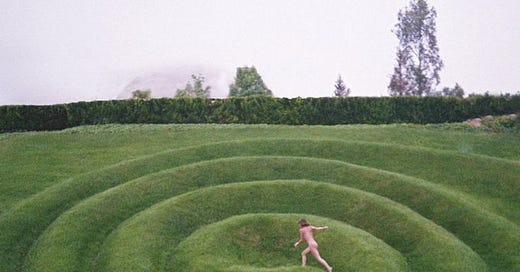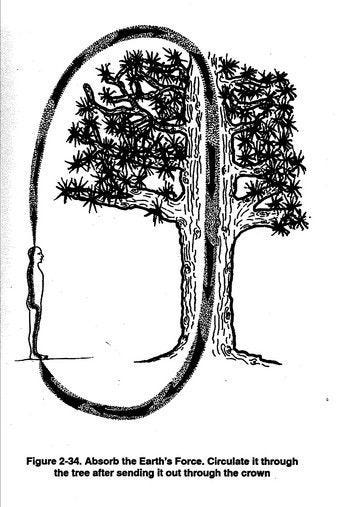October’s conclusion today marks the close of the fourth month of CITTOC living in the world before your very eyes. It’s a duration that feels like a meaningful milepost to stop and observe from. Maybe that’s because we’re at the beginning of a season when the veil between the spirit and the living feels that much thinner, when a unique kind of profundity emerges. An intention I had at the start of this project was to celebrate the wins, to savor the process, and to not get lost in goals or metrics. I wanted to avoid those habits that would distract from the meat of this experience or obscure the freedom of this project to reveal itself organically. That intention has proven to be more daily practice than fixed reality, and I have definitely faltered in its pursuit at times.
These four months have emerged with the roundness of a season. Perhaps living in the land of no seasons here in Austin—where it goes from mostly just hot to a parenthesis of wildly sublime with a manic pendulum swing of freezing to utterly unpredictable in between—has skewed my perspective of natural cycles. For whatever reason, for me, right now, four months into this project seems an apt time to pause for reflection. Reflection has always been a step in the creative process that historically I have been remiss to make space for. But what is this project if not a chance to evolve, to learn, and to change? In order to look forward, one must briefly look back.
In revisiting these first conversations of what I will now call, half-jokingly and entirely lovingly, Season One of Creativity in the Time of Capitalism, I want to share some of the main takeaways that have emerged in the beautiful clarity that is hindsight.
In my first conversation with Hallie Brewer, after a career spent in the service of others' creative visions, she taught us the necessity of detaching the gaze of the would-be patron from the creative process. She suggests instead that we work from a place of surrender to the creative act itself, being especially mindful that market palatability should not be allowed to eclipse this surrender. It is the return to an internal, rather than an external, gaze. And also a reminder that trading security for freedom is the creative’s birthright.
My second conversation with Kelly DeWitt taught us the importance of kindness, collaboration, and respect in the creative process. Her description of the ideal creative act evoked her discussion of and adoration for choral music—the coming together of harmonious yet distinct voices. Voices that honor a common goal with a precise execution that is both singular and communal, and where each voice is valued. She also emphasized that the “how” and the “why” behind creating spaces is just as important as the spaces (or any creative outcome) themselves. To be true in our intentions, from all stations of the creative cycle, matters.
My third conversation with Xochi Solis taught us that the pressure of monetization in one’s creative life is a choice, that there is more than one way to go about making a living while living a creative life. She encouraged us to free ourselves from the idea that grinding is inevitable, or that subsisting solely from the fruits of one primary creative pursuit is the only option. Her advice is to broaden the definition of your creative practice and to diversify your creative portfolio. She also spoke to the freedom to exist in multifaceted arrays of expressions as a creative, to flex every muscle of interest, regardless of the perception of others or the financial gains.
My fourth conversation with Keith Kreeger taught us the importance of a Process First approach, one that allows for spontaneity, experimentation, and communion rather than the rote repetition of a production-oriented creative practice. He also emphasized the importance of allowing yourself to live alongside your work, something that is not usually possible within the context of a manufacturing mentality. Finally, he invited us to take risks, wagering our “yeses” and “nos” with intention, and allowing the language of our creative process the right to evolve, just as we ought to allow ourselves to do.
Four months of this project has also given me a lot of time to fret over its existential implications, to worry about whether or not I am delivering you, the reader, with what you came here expecting or hoping for. Writing, I have learned, is very different from any role I have previously held. There is a silence, an isolation, in this practice that I sometimes struggle with. I think that is why these conversations with other creatives, and the communion that they bring, have become so meaningful and integral a part of Creativity in the Time of Capitalism.
In this next season of this project, we will begin a series of conversations with creatives in the field of fashion. Fashion is an area that I both know in my marrow, and have been prone to avoid of late. As a result, these talks have felt like a homecoming and further space for meaningful reflection. The unique pressures and constraints of this field are not for the faint of heart, though I am sure that this is the case with all creative disciplines once you have known them intimately. The reason I have felt called back to this field at this particular moment is the spate of closures of late in the independent and sustainable fashion space, from Mara Hoffman to Ilana Kohn. I see a void forming in the culture of this field, and I genuinely wonder what the future holds for those legacy brands that are not venture capital-backed or conglomerate-owned, and what path is being left for those who might rise in their place. Is an alternative methodology that honors people and planet still possible? The answer remains to be seen. I think the best note to leave this topic on for the time being is this beautiful excerpt from Mara Hoffman’s closing letter, published on her website, especially now as we move towards the more inward and incubationary months ahead:
Maybe we all need to see someone make this choice. To show us that endings of cycles are also beautiful and that there is so much grace to be had when we lovingly LET GO when it is time. When we can trust in a new version that is forming even when we cannot see it yet. When we actively choose something else, something embedded in love, healing and Truth as opposed to staying put in something that has run its course. I take solace in knowing that if I move in the direction of what is true to me it will help inspire others to do the same for themselves.
A necessary reminder that endings may be hopeful and empowered, more release than remorse. There is something to celebrate in having the strength to let go, in the wisdom that tells us to stop clutching and clinging. The ensuing absence, while a void, creates space. It is a space that will ultimately be occupied by shapes unknown, yet inevitable. We cannot stop the force within us that wills renewal, rebirth, and change.
During this pause for reflection, I want to take a moment to thank you so much for being here and standing with me through the first season of the ever-evolving project that is CITTOC, I truly couldn’t (and wouldn't) do it without you. I will see you in the new month (our fifth!) with a fresh conversation, the first of our new season, that I hope you will relish as much as I did.
In the meantime, I would love to know if there has been anything in these first four months that you have found especially meaningful or memorable. Has anything you’ve come across here sparked something in your own creative practice or life? Let me know in the comments; I want nothing more than to hear from you.
Until soon,
Miranda







So beautiful. I'm really looking forward to reading your conversations with creatives in the field of fashion and hearing your take (wise and funny, as always) <3
Hundreds, maybe thousands, of interviews with entrepreneurs and artists are published daily. I find the most value in those that are in-depth and detailed, like these four conversations. What stands out most is the thoughtfulness of the questions and the honesty and vulnerability in the responses. Side note—reading an interview rather than listening to it felt refreshing. Thank you for being here, Miranda.